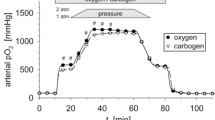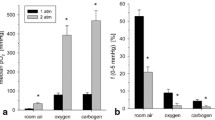Background:
Tumor hypoxia has proven prognostic impact in head and neck cancers and is associated with poor response to radiotherapy. Hyperbaric oxygenation (HBO) offers an approach to overcome hypoxia. We have performed pO2 measurements in selected patients with head and neck cancers under HBO to determine in how far changes in the oxygenation occur and whether a possible improvement of oxygenation parameters is maintained after HBO.
Patients and Methods: Seven patients (five male, two female, age 51–63 years) with squamous cell cancers of the head and neck were investigated (six primaries, one local recurrence). The median pO2 prior to HBO was determined with the Eppendorf histograph. Sites of measurement were enlarged cervical lymph nodes (n = 5), the primary tumor (n = 1) and local recurrence (n = 1). Patients then underwent HBO (100% O2 at 240 kPa for 30 minutes) and the continuous changes in the oxygenation during HBO were determined with a Licox probe. Patients had HBO for 30 minutes (n = 6) to 40 minutes (n = 1). HBO was continued because the pO2 had not reached a steady state after 30 minutes. After decompression, patients ventilated pure oxygen under normobaric conditions and the course of the pO2 was furhter measured over about 15 minutes.
Results: Prior to HBO, the median tumor pO2 in the Eppendorf histography was 8.6 ± 5.4 mm Hg (range 3–19 mm Hg) and the pO2 measured with the Licox probe was 17.3 ± 25.5 mm Hg (range 0–73 mm Hg). The pO2 increased significantly during HBO to 550 ± 333 mm Hg (range 85–984 mm Hg, p = 0.018). All patients showed a marked increase irrespective of the oxygenation prior to HBO. The maximum pO2 in the tumor was reached after 10–33 minutes (mean 17 minutes). After leaving the hyperbaric chamber, the pO2 was 282 ± 196 mm Hg. All patients maintained an elevated pO2 for further 5–25 minutes (138 ± 128 mm Hg, range 42–334 mm Hg, p = 0.028 vs the pO2 prior to HBO).
Conclusions: Hyperbaric oxygenation resulted in a significant increase in the tumor oxygenation in all seven investigated patients. A significant increase at the point of measurement could be maintained for several minutes after decompression and after leaving the hyperbaric chamber.
Hintergrund:
Hypoxie in soliden Tumoren ist mit schlechter Prognose und schlechtem Ansprechen auf Bestrahlung assoziiert. Hyperbare Oxygenierung (HBO) könnte genutzt werden, um den Oxygenierungsstatus von Tumoren zu verbessern. Wir haben deshalb die Veränderungen der Tumoroxygenierung unter HBO untersucht.
Patienten und Methodik: Sieben Patienten (fünf Männer, zwei Frauen, Alter 51–63 Jahre) mit Plattenepithelkarzinomen im Kopf-Hals-Bereich (sechs Primärtumoren, ein Lokalrezidiv) wurden untersucht. Der mediane pO2 vor HBO wurde mit dem Eppendorf-Histographen gemessen (fünfmal in zervikalen Lymphknoten, jeweils einmal in der Primärtumorregion bzw. im Lokalrezidiv). Die Patienten erhielten dann eine HBO (100% O2 bei einem Druck von 240 kPa für 30 Minuten). Vor und während der HBO wurde die Oxygenierung im Tumor mittels einer Permanentsonde (Licox-System) an einem Punkt gemessen. Nach Ende der Dekompressionsphase atmeten die Patienten weiter reinen Sauerstoff bei normalem Druck, und der Verlauf pO2 wurde über weitere 15 Minuten gemessen.
Ergebnisse: Vor der HBO betrug der mediane Tumor-pO2 in der Eppendorf-Histographie 8,6 ± 5,4 mm Hg (Spanne 3–19 mm Hg), der mit der Permanentsonde gemessene pO2 war 17,3 ± 25,5 mm Hg (Spanne 0–73 mm Hg). Der pO2 stieg während der HBO signifikant an auf 550 ± 333 mm Hg (Spanne 85–984 mm Hg, p = 0,018). Dabei zeigten alle Patienten einen Anstieg unabhängig vom Oxygenierungsstatus vor HBO. Der maximale pO2 im Tumor wurde nach 10–33 Minuten (im Mittel nach 17 Minuten) erreicht. Bei Verlassen der Überdruckkammer betrug der pO2 282 ± 196 mm Hg. Er blieb auch während der anschließenden normobaren Sauerstoffatmung über 5–25 Minuten signifikant erhöht (138 ± 128 mm Hg, Spanne 42–334 mm Hg, p = 0,028 gegenüber dem pO2 vor HBO).
Schlussfolgerungen: Hyperbare Oxygenierung führte bei diesen Patienten zu einer signifikanten Verbesserung der Oxygenierung, die über Minuten nach der Dekompressionsphase anhielt. Für eine klinische Studie könnte deshalb ein strahlensensibilisierender Effekt auch dann erreicht werden, wenn die Bestrahlung nicht simultan, sondern unverzüglich nach einer HBO erfolgt.
Similar content being viewed by others

Author information
Authors and Affiliations
Additional information
Received: May 14, 2001; accepted: October 26, 2001
Rights and permissions
About this article
Cite this article
Becker, A., Kuhnt, T., Liedtke, H. et al. Oxygenation Measurements in Head and Neck Cancers during Hyperbaric Oxygenation. Strahlenther Onkol 178, 105–108 (2002). https://doi.org/10.1007/s00066-002-0892-0
Issue Date:
DOI: https://doi.org/10.1007/s00066-002-0892-0



